Communicating effectively with project stakeholders helps in managing expectations, everyone is on the same page. It reduces some kind of misunderstanding, it reduces/manages risks. And it builds a stronger bond amongst the team. Effective communication is crucial for project success. Here are some tips to help you communicate effectively:
Identify Stakeholders: Determine who your project stakeholders are, including clients, contractors, team members, regulatory authorities, and other relevant parties. Create a stakeholder list and categorize them based on their level of influence and interest in the project.
Understand Stakeholder Needs: Analyze the expectations, priorities, and concerns of each stakeholder group. Consider their perspectives, goals, and potential impact on the project. You can go extra by trying to understand stakeholder’s personality. Like the kind of things that interests them. This understanding will help your communication approach.
Choose Appropriate Communication Channels: Select the most suitable communication channels for each stakeholder group. Some stakeholders may prefer face-to-face meetings, while others might prefer email, phone calls, or online collaboration tools. Use a combination of channels to ensure effective communication.
Tailor Your Message: Adapt your communication style and content to resonate with each stakeholder group. Use clear, concise, and jargon-free language to convey information. Highlight the benefits and relevance of the project to their specific interests.
Establish Regular Communication Routines: Schedule regular meetings, updates, and progress reports to keep stakeholders informed. Establish a communication plan that outlines the frequency, format, and content of communication for each stakeholder group.
Actively Listen: Pay close attention to stakeholder feedback, concerns, and questions. Practice active listening to show empathy and understanding. Encourage open communication and provide opportunities for stakeholders to express their opinions and concerns.
Be Transparent and Honest: Foster trust and credibility by being transparent and honest in your communication. Share both good and bad news promptly. Address issues and risks proactively, providing realistic assessments and potential solutions.
Provide Context and Relevance: Help stakeholders understand the bigger picture and how their involvement contributes to the overall project objectives. Provide context and explain the relevance of their role and the project outcomes.
Use Visual Aids: Utilize visuals such as charts, diagrams, and infographics to help stakeholders grasp complex information more easily. Visuals can enhance understanding and engagement during presentations, reports, or discussions.
Document and Follow-Up: Keep a record of important communications, decisions, and agreements with stakeholders. Follow up promptly on any actions or commitments made during discussions. This helps to ensure accountability and alignment.
Be Open to Feedback: Encourage stakeholders to provide feedback on the project and communication process. Act on valid feedback and make necessary improvements. Regularly assess the effectiveness of your communication and adjust it as needed.
Remember, effective communication fosters trust, builds strong relationships, and enhances collaboration with stakeholders. It is a continuous process that requires active engagement and responsiveness throughout the project lifecycle.


Write a Comment